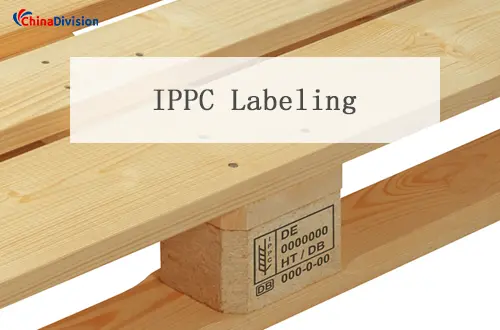Does the Packaging of Exported Goods Need Ippc Labeling
When exporting goods, when does the wooden packaging need to be affixed with IPPC labels and fumigation certificates? Ensuring that the goods arrive at the destination safely and in compliance with regulations is the top priority for every B2B company.
Table of Contents
What is the IPPC labeling on the pallet?
The IPPC labeling is an internationally recognized mark used to prove that the wooden packaging has undergone specific quarantine treatments and meets the standards of the International Plant Protection Convention. These treatments include heat treatment or fumigation to ensure that the wooden packaging materials do not carry pests, thereby protecting the agricultural and forest resources of the importing country.
Situations where the IPPC labeling is required for goods packaging
If your export goods packaging contains solid wood components and the destination is a country such as the European Union, the United States, Canada, Japan, Australia, etc., then your wooden packaging usually needs to have an IPPC labeling. The requirements for IPPC labels may vary greatly from country to country. Even if the solid wood part of the packaging accounts for a small proportion, as long as there is solid wood, it is generally required to be labeled.
Several key factors that require compliance with the International Plant Protection Convention (IPPC) labeling requirements:
Composition of packaging materials
Packaging of solid wood products: When your export cargo packaging contains solid wood parts made of natural wood, such as wooden boxes, wooden crates, wooden pallets, wooden frames, wooden barrels (except oak barrels for wine), wooden axles, wooden wedges, wooden pads, sleepers and linings, the IPPC labeling is usually required. Even if the solid wood part accounts for a small proportion of the overall packaging, as long as there is solid wood, it is required to be labeled in most cases.

Packaging of artificial wood materials: If the packaging is entirely made of highly processed artificial boards such as plywood, particleboard, fiberboard, etc., the IPPC labeling is usually not required because these materials have a very low risk of carrying pests. Similarly, packaging made of thin boards (including shavings, sawdust, etc.) with a thickness of less than 6 mm does not require this labeling.
Requirements for export destinations
Specific countries and regions: Although different countries and regions have different quarantine standards for wood packaging, wood packaging exported to the European Union, the United States, Canada, Japan and Australia, if it contains solid wood parts, generally requires the IPPC labeling. However, even if you export to other countries, you should understand the specific regulations of that country on wood packaging in advance to determine whether the IPPC mark is required.
Cargo characteristics and transportation mode
Cargo nature: Specific goods may be vulnerable to biological invasion or have high requirements for biosafety. Even if their packaging is not all wooden, as long as they are in contact with or have potential impact on wooden packaging, they may need to follow the quarantine regulations for wooden packaging to determine whether the IPPC mark is required.
Mode of transportation: Although there may be slight differences in packaging quarantine regulations for sea, air, and land transportation, the basic principle of whether wooden packaging needs IPPC marking remains the same. That is, it is determined according to the composition of the packaging material and the specific requirements of the export destination.
Difference between IPPC standards and fumigation certificates
IPPC mark
Refers to the management measures for wooden packaging materials formulated in accordance with the International Plant Protection Convention, which require specific treatments (such as heat treatment or fumigation) and the application of IPPC marks to prove that they meet the standards for preventing the spread of pests. The IPPC mark is a permanent mark applied to wooden packaging, indicating that the packaging has been heat-treated or fumigated and meets the standards of the International Plant Protection Convention. The IPPC logo usually includes a country code, an enterprise code, and a treatment method code (e.g. MB for methyl bromide fumigation, HT for heat treatment).
Key points of the IPPC standard include
Treatment methods: Common methods include:
Heat treatment (HT): Heating the wood until its core temperature reaches 56°C for at least 30 minutes.
Fumigation: Using gases such as methyl bromide to kill pests.
Marking: Treated wood must carry an official mark indicating compliance with ISPM 15.
Fumigation certificate
is a document that certifies that the wood packaging has been fumigated to kill pests. Fumigation certificates are usually issued by the certification body after the fumigation treatment is completed and are valid for 21 days. Some countries may require a fumigation certificate even if the wood packaging has an IPPC logo.
Although fumigation is a treatment method that meets the IPPC standard, obtaining a fumigation certificate does not automatically meet all IPPC requirements. It is also necessary to ensure that the IPPC logo is correctly applied to the packaging and that other relevant regulations are met.
How to choose packaging materials?
When choosing between polybags and plastic boxes, you should consider the protection needs of your merchandise, cost-effectiveness, and environmental impact. Polybags are lightweight and less expensive, making them suitable for lightweight goods, while plastic boxes are more structurally sound and suitable for goods that require additional protection. In addition, consider using recyclable or biodegradable materials to reduce environmental impact.
As a B2B business, by complying with IPPC standards, you can ensure smooth customs clearance and adherence to international regulations, helping you avoid delays and fines. If you are unsure of your packaging requirements, working with a third-party logistics provider such as ChinaDivision can streamline the process and ensure your shipment meets all necessary standards.





